Welcome to TribalBellyDance.net
Narah ~ Tribal Fusion Belly Dance Performer and Instructor
Pre-17th Century Middle Eastern Dance
By Kimberly A. Minardi
(AKA Narah)
*Before you read this paper, note that it is my property, the information was compiled over many hours, and should you use the information, I expect credit for the compilation of the research*
To study Middle Eastern dance and attempt to gain an accurate picture is a difficult task. As dance during the time and places of Islam (the primary political power in the region known as the Middle East) was viewed as a both a treasure and as disreputable, it is difficult to obtain information which provides sufficient concrete information. For example, “historically, Iranians rarely, if ever, wrote about dance. Our evidence of dance lies chiefly in the descriptions written by foreigners, while the native view of dance is iconographic because in certain periods and in particular genres of art, dance was portrayed visually by Iranian artists.” (Shay 1999) He later discusses the limitations of using iconographic evidence. Shay also explains that because the primary sources for [Persian] dance research are iconographic sources and Western writings, the researcher must spend numerous hours searching in obscure documents for shreds of evidence to work with. He says,
“Piecing together a history based on extant sources is an arduous task. The depictions of the artwork and the literary references are considerably fragmented. Most of the works are not indexed by the subject depicted in the art, but rather, the focus of most studies has been on the technical aspects of the art… Thus, in order to find pictorial or other references to dance activity, a researcher must spend many long hours combing through books and museums in order to piece together even the sketchiest historical record. The same applies to the writings of Westerners, since they are not generally indexed under "dance," and must be consulted individually, and these works are often long, such as the travel journals of Chardin, which appear in eight volumes, as several truncated editions.”
In addition to limited and difficult to find information, Harding notes that,
“ Part of the problem in researching any type of eastern performance art or persona is that it involves so many different cultures, and has developed in so many different forms. But, in spite of all this, there is still something that can be readily identified as … [Middle Eastern Dance]. Research also reveals that it is impossible to completely separate the history of … [Middle Eastern Dance] from Gypsies, Spanish dance, Indian dance and Persian dance”.
These perimeters having been set, “abundant iconographic evidence of solo improvised dance [in Persia] or a similar and related dance form exists, and attests to its presence for more than six thousand years.” (Shay 1999) The origins of Middle Eastern dance are ancient. They can be traced back to fertility cults and matriarchal religious rites. The dance celebrated not only the fertility of couples, but of the earth and rivers. You can see elements of this in the dance today in various hip movements and arm movements.
After it became Islamic custom to house women separately in harems, the women would use the dance to entertain each other. Dancers also performed as troupes or in pairs and developed choreographies.
“It is said that the expenditure in Silhadi’s (Silhadi of Raisen [1532]) household on women’s dresses and perfumes exceeded that in any king’s palace. He had four akharas, that is to say, ‘bands’ of dancing –girls, who were each unrivalled in their special art. Forty women held the torches while the dancing-girls performed. Every dancing-girl, moreover, had two attendants, one of whom held her pan-box, and the other poured sweet-scented oil on the torches, for they never burnt any bad scenting oil, nor any that was not odorous, that is, not scented with rose-perfume. All the women’s clothes were of gold brocade, or embroidered with gold”. (Hambley 1998)
“Fernao Nuniz wrote that the ruler of the Vijayanagar empire (1336-1565) [had] within his gates more than four thousand women, all of whom [lied] in the palace; some of whom are dancing girls.” (Hambley 1998) Hambley wrote that in the reign of Shah Sulayman, there was a troupe of royal dancers, and that female dancers, along with other entertainers were included in the visitors to the harem.
“By the end of the first century AD performers had organized into companies in Egypt and other countries of the East. The following extract from a papyrus in the possession of Cornell University includes a contract between an Egyptian performer and her employer:
To Isidora, castanet dancer, from Artemisia of the village of Philadelphia. I request that you, assisted by another castanet dancer- total two- undertake to perform at the festival of my house for six days beginning the 24th of the month Payni according to the old calendar… (Buonaventura 1998)
Shay speaks of “a seal carved on rock, dating from the middle of the third millennium BC and found at the important site of Shush (Susa), shows two female solo dancers performing for two men in a banquet scene, the beginning of this historical odyssey of retrieving evidence for this movement practice. The depictions of dancers in a wide variety of art forms confirm the popularity of this dance practice.
Retaining its fertility-cult roots, women in tribal cultures as well as city-dwelling women used the dance as comfort for a woman in labor. The dancers gathered around the woman giving birth and performed movements sympathetic to the labor process. This form of dance was also taught to young girls to strengthen muscles used during childbirth, like our modern la maz classes. Many times, women performed the dance for women, or it was performed by men for men. As is the case today, often in the Middle Ages, men and women were separated for most social occasions. However, there is one documented case of a brother and sister performing a sword dance together, and there are many cases of professional dancers performing in courts. Shay states that in virtually hundreds of [Persian] miniatures and other iconographic sources that have been located over the past several years, dancing almost exclusively appears in only two genres: weddings and fetes such as enthronements and banqueting scenes.
“The armies of the Roman Empire (27 BC-AD 476) spread out across the Mediterranean into Egypt and Arabia, North Africa and Europe. Whatever their qualms about dance as an activity for respectable citizens, the Romans appreciated it as a diversion, and around 60 BC they imported dancers from Syria to entertain them. Propertius, the greatest elegiac poet of ancient Rome, mentions women being hired to enliven a banquet, where ‘they danced lascivious dances to the sound of flutes, and accompanied themselves with castanets’. (Buonaventura 1998)
The Gypsy (Romani) Connection
“Secular entertainment evolved as the gypsies traveled from India through the Middle East, Central Asia, and Spain.” (Carolena Niriccio)
“The original gypsy tribes left India in the fifth century AD in search of work, and the escape from the many famines and hardships of life… The first Gypsy tribes migrated west through Afghanistan and Persia, and on the eastern shores of the Mediterranean their ways divided. Some continued in a northerly direction via Turkey into Europe, while others followed the southern coastline to Egypt. It is believed that they reached Spain via the northern shores of Africa. For hundreds of years, they have made their living as public performers. The have no written history; instead, their story has been kept alive and transmitted from generation to generation by means of music, song and dance. There are two kinds of Gypsy entertainment: one remains private, the other has shaped their public repertoire.” … “The Persian poet Firdusi describes how the fifth century King Bahram brought nearly 1000 gypsies to Persia to entertain his subjects, who had been complaining that the pleasures of dance and music were reserved for the wealthy.” (Buonaventura 1998)
The private and public repertoires are why Middle Eastern dance and Gypsy dance are different. Gypsies were known for using entertainment as a means of making a living. This dance was one way to make money. A dancer’s dowry was usually earned by dancing on the street while passers by threw money to the dancer. She would then sew the coins onto her clothes, since this was the safest place to keep it. As the Gypsies were travelers and picked up local trades, such as dancing, they were probably largely responsible for “mixing” the different regional styles. “When they did settle, Gypsies assimilated the local traditions and made them their own. They took native folk dance and music, amplified and polished them, and then went on the use them as a means of livelihood.” (Buonaventura 1998) This is why you may see an Indian head slide followed by a Turkish hip circle. They also likely had a variety of clothing styles as they would keep what they had picked up from the previous land until they collected enough pieces from the current place.
However, “Gypsies were not the only ones responsible for the dissemination of this dance, despite the fact that they played a major part in its development. Women who traveled with the invading armies of successive colonial powers also had a hand in taking it from country to country.” (Buonaventura 1998)
The social role of the dancer:
The social role of the dancer is a topic of great debate: often portrayed as being of lower class, but with special privileges and reverence, the actual status is confusing at best. One must also remember that there is a difference between a professional dancer and one who dances with family members during a celebration.
Walter reports that “from the end of the sixteenth and the beginning of the seventeenth century, the constantly growing influence of the Indian environment on Mogul culture became increasingly apparent in fashion … at this time, the head coverings of the ladies were symbols of rank. ‘Some of these princesses wear turbans by the king’s permission. On the turban is a valuable aigrette, surrounded by pearls and precious stones … During festivities, such as balls and the like, there are dancing-women who have the same privilege’. This shows the regard in which dancers were held at Court.” Indeed, dancers were often depicted in Persian miniatures at court and represented a happy and joyous occasion.
The other side of the coin may be part of the reason obtaining sufficient research information for Middle Eastern dance is difficult. Shay suggests that the reason Iranians did not write about dancing or dancers except in a metaphorical way in Persian poetry is largely due to the low social status of professional dancers and the indignity of dancing, activities with which these writers did not with to be associated. Entertainers in general were not looked upon as those who placed high in society.
“In Muslim cities in the Middle Ages, several occupations were… infamous. On religious grounds, the usurers ranked first among the disreputable. Neither were traders of silver, gold, and silk highly regarded. Others who profited from transactions forbidden by Muslim law, such as moneylenders, slave dealers, wine sellers, and pork sellers, were also disapproved of. Professional mourners, too, were frowned upon on religious grounds. Prostitutes, dancers, and other entertainers, such as wrestlers, players, storytellers, and singing women, were suspected of a questionable morality and associated with vice and begging. Other despised occupations that were not forbidden but that were blameworthy or rejected in Islam were those whose practitioners were defiled by dead animals or animal waste matter, including butchers, tanners, hunters, and waste scavengers. Camel and donkey drivers, shepherds, bath attendants, veterinarians, watchmen, and stablemen were considered to have low occupations and were looked down upon… In the eyes of religious authorities, entertainers were outside the community of believers. A second characteristic concerns the relations that members of dishonorable professions all had with the worldly authorities. Especially the lack of a permanent residence and a presumed lack of morality prompted the governors to undertake actions against entertainers … A third characteristic of infamous occupations is that their practitioners in European as well as in Muslim countries had a weak legal status. [They] were authorized neither to hold the position of a judge nor to act as a witness. They were not authorized neither to hold the position of a judge nor to act as a witness. Quite often they were not compensated for injustices done to them… Members of infamous occupations were often physically segregated as dishonorable persons and could be distinguished by their outward appearance. Usually they were not ethnically different from the respectable citizens, so the otherness of the infamous was created by artificial means-for instance by prescribed clothes or colors. … Entertainers were recognizable by their colorful and varied attire… Entertainers were marginal to the community as a result of their mobility, which made them strangers and outsiders. Entertainers and other dishonorable persons who either were itinerant or worked outside the towns and villages were stigmatized in still another way. They evaded the control of the worldly and religious authorities and were less subject to social control as well. For that reason, they were connected with heretical ideas, rebellion, frivolity, and illegal activities. They were seen as dangerous and receptive to unorthodox ideas. [Ginzburg 1980:120] (Nieuwkerk 1995)
Buonaventura notes that dancers “transgressed the basic tenet of Islam … that women should not display their bodies in the presence of strangers… and appeared unveiled in public.”
This excerpt from an article by Jalilah Lorraine Chamas (The Gilded Serpent http://www.gildedserpent.com/articles20/jalilahharamslaves.htm) gives further insight on the status of dancers:
"History
Many misconceptions are
distortions of the truth, and such is the case with the harem / slave myth and
Oriental dance. Throughout history, rulers worldwide have had entertainers,
including dancers, in their courts. Arab / Islamic history is no different.
However, the reality is always more complicated than the myth.
From pre-Islamic times until the 800s, professional dancers, musicians, and singers in the Middle East belonged to the slave caste. The majority of professional musicians, including singers, were female slaves, and they were often called “Qaina.” (Even in recent times, the majority of professional entertainers come from the lower classes, and both of these facts are part of the reason why there is still a stigma today against being a professional entertainer in the Middle East.) The term “Qaina” originates from the legend that music and dance were “invented” by a biblical character, one of Cain’s daughters. Although the Qaina are often referred to as “singing girls,” there are numerous historical references to them as musicians and dancers as well.
The Qaina were in fact highly-educated women who, besides being trained extensively in singing, music, dance, and poetry recitation, were also often educated in literature, calligraphy, philosophy, and the sciences.
There are several references to the Qaina in Tales of 1001 Nights.1 (Centuries later, female professional entertainers called “Awalim” (meaning learned or educated) followed a tradition similar to the Qaina, except that the Awalim were not slaves.)
The period starting in the 700s and extending to about the 1400s is often
referred to as the “Golden Age” of the Islamic civilization. At this time, the
Islamic Empire stretched from
During this time, the Qaina played an important role in the development of music and poetry.
Muslim scholars mention little
about dance; however, one can assume that dance also developed at this time
under the patronage of the Umayyad (Damascus and
Even though technically slaves, the Qaina possessed more freedom than many women have today in some parts of the world, and although their profession had a stigma attached to it, they nevertheless had an elevated social status. Numerous historical references describe the Qaina as wearing more brightly colored clothing, and more ornaments, as well as speaking their minds more freely than other women.
Sometimes, they exercised considerable political power as well. According to the Islamic historian Ibn Hazm, “Of the 37 of Abbasid Caliphs, only 3 were sons of “free” mothers, and among the Umayyads, not a single son of a free woman succeeded in becoming Caliph”!2 One of the greatest and most famous Arab Rulers was Harun El Rashid, who ruled in Baghdad in the 700s. Khayzuran3, his mother, was originally a slave, but other sources mention that she had also been a Qaina, trained in Mecca. Khayzuran not only became the favorite of her husband, Al Mahdi, but also helped him make important political decisions. In addition, she succeeded in getting both of her sons chosen as heirs to the throne, instead of Al Mahdi’s other sons by his aristocratic first wife. When her son Harun El Rashid became the Caliph, Khayzuran continued to play an important role in the Empire’s politics, and her son was known to ask for her advice on almost every matter."
Middle Eastern Dance pre-17th Century: What it looked like.
“Arabic dance is characterized by its intricate hip movements which, to judge from fragments of description down the years, have changed little in essence in the last 1,000 years or so, although they have been augmented and refined.” (Buonaventura 1998)
Middle Eastern dance has been passed down orally. Anthropologists consider oral history a valid tool to reconstruct the past. As there were no video cameras to show us exactly what it looked like, we rely on this method as well as others to develop a likely representation of Middle Eastern dance prior to the 17th century.
As is consistent with some anthropological and archeological theories, we compare what we know of today to what evidence exists of the dance before the 17th century to come up with a plausible picture of how it was actually danced. One method is to use written descriptions:
“In ancient Greece there existed a number of fertility dances based on pelvic rotation, swaying of the hips and an exaggerated shaking of the bottom. Lillian B. Lawler groups together several dances in which ‘the characteristic motion is a rhythmical and voluptuous rotation of the hips, suggestive of stirring or grinding.’ One was known as the igdis or ‘grinding mortar’ dance. In another, ‘the performer rotated the hips and jerked the body in a manner reminiscent of the motion of a pestle being used to grind food in a mortar’. Coupled with this dance was a movement, which translates as ‘writing, twisting, as a willow wand’. The ancient Greek writer Pollux linked together all these dances, which he characterized by their ‘swaying rotation of the hips’. In The Metamorphosis by Apuleius, a girl stirring a pot on the fire attracts a young man’s attention by the rhythmic swaying of her hips and shoulders. … “In Cadiz in the first century AD dancers performed ‘sinking down with quivering thighs to the floor’. * … The second century historian Pausanius tells us that in classical Greece temple priestesses performed a dance known as the kordax, which involved a rotation of the hips while the feet were held closely together. … The Romans’ greatest enthusiasm… was reserved for the dancers of Cadiz (Gadez, as it was then known). Its dancers were celebrated by several Roman writers, including Ovid, who has left the following description: ‘Graceful her arms, moving in subtle measure; insinuating she sways her hips’. Juvenal described dancers who ‘sink to the ground and quiver with applause [this description sounds like a “level change” with a shimmy]… while the poet Martial recorded seeing them ‘swing lascivious loins in practiced writhings’. This dance was enjoyed from one end of the Roman Empire to the other. … In the seventh century AD a Persian scholar, describing the chief attributes of a great dancer, pointed out’ a marked agility in twirling and swaying the hips.’ On Indian temple dances: ‘Of all their arts, dancing is the most highly cultivated… consisting of a pantomime made up of the most graceful and alluring dramatic action, gestures, twistings and marvelous undulatory and expressive motions of the torso.’ (Buonaventura 1998)
Harding notes the following:
“The first century writer Martial and his contemporary Isidore of Seville mention a dancer performing moves characteristic of eastern dance, and using a rhythmic instrument. Martial refers to the skill of the women of Gades (Cadiz) in his lines on Telethusa, who was so bewitching that, the man who acquired her as a slave brought her back as a wife. He has seen her in the market place “performing wanton gestures to the accompaniment of Baetic castanets, which she had been taught to play in the manner of the Gaditaian women.” These dancers of Cadiz* are thought by Esther Van Loo to be Phoenician or Cretan in origin. This is a reasonable assumption because there were Phoenician traders in Spain as early as the eleventh century BC, and Cadiz, one of the oldest towns in Europe, was founded by the Phoenicians. … In Virgil’s “Copa”, the tavern hostess dances in front of her inn to lure a passerby: ‘A Syrian tavern-hostess, her head tied in a Greek scarf, trained in moving her quivering sides to the Crotalum, springs gaily drunken from her smoky inn shaking her rattling reeds against her elbow… Whatever type of rhythm instrument she is playing, be it a pair of clappers or metal or wooden castanet, her dance sound distinctively like … [Middle Eastern Dance]… [More specifically, this movement sounds like a “shimmy”, which is a rapid up and down movement of the hips driven by leg movement, thus the “quivering sides”.] …
The Song of Solomon has been retranslated by Suares as ‘The curves of your hips seem to torment themselves’ [again this sounds like a “shimmy”] …
From her study of tomb drawings, Lexova identifies one step as being the most fundamental of Egyptian steps: one the modern [Middle Eastern dancer] would call a “down”… on a “down” the hip goes down when the foot goes down. … The “down” is still a very typically “Egyptian” step…
Around 1500BC the Egyptians brought the Bayaderes, who were the elegant temple dancers of India. As an ancient text describes, the dances were becoming less like marches and more elegant: ‘the lines flow softly and pleasantly; nowhere do they bend sharply or break; and even where the mood is impetuous and impassioned, the movement remains close… [This further emphasizes the fact that dancers of different cultures and different styles interacted and blended their dances.]
The Ghawazee [a tribe of Gypsies who were first documented right out of the focused time period. This tribe came to be known as the dancers of Egypt and often dancers were called Ghawazee whether they were or not] cane dance witnessed by Qamar did include … a very interesting and distinctive step. It is a step-hop, which the National Folkloric group calls the “tawalli” step… The step is basically a hop on one foot, and a lifting of the other leg with the thigh horizontal to the floor at hip level, and the leg bent downward at the knee. In addition to being a very folkloric move, it also bears great similarity to the hop-step shown in pictures of Turkish dancing boys and girls. … The dancing girls and dancing boys are a recognized institution throughout the Near East; they were the actors and actresses of their time. However, so little is known about them because dancing was regarded by the scholarly writers of the past as an “improper and wicked sport:, especially when indulged in by professionals… by the mid 1600’s there were said to be some three thousand of these dancers, in approximately twelve companies. … [The dancing girls’] dancing was described as suggestive contortions, a good deal of stomach play and twisting of the body, falling upon the knees with the trunk held back (a backbend) ** to the extent that the spectators were encouraged to put a coin on their forehead. This is the same custom observed in Egypt called “nukoot”. Every muscle and both shoulders were made to quiver (i.e. shimmy). [There is also an isolated shoulder shimmy created by moving the shoulders in a forward and backward direction].
*
*This actually sounds more like a Turkish drop; a backbend, while it can be done on the knees, is generally performed standing up. Dropping to the knees with the trunk held back is known as a Turkish drop.Though some of Harding’s information is after the 17th Century [Ghawazee], it does give us great insight into the appearance of the dance by its similarity to moves both in period and from today.
While “in its own society, Arabic dance has rarely been the subject of study and representation in the arts” (Buonaventura 1998), those representations that do exist may be used to assist in our quest to know the dance as it was. However, as Anthony Shay points out, there are limitations to using Iranian iconographic sources for the development of historical evidence of [at least] Iranian dancing. He warns that using Persian miniatures as photographic evidence, or assuming that the art is representative of something “real” may not be a reliable method. He notes that the dance figures are stylized and indicates only that dance is occurring. However, he does admit that
“in spite of their limitations, [he is] convinced that iconographic and pictorial sources can provide us with certain kinds of valuable information on some aspects of dancing and dancers. That includes limited evidence of movement practices, clues regarding performative conventions, aesthetic canons, musical accompaniment, the social position of performers, clothing, issues of space, numbers of performers and circumstances of performance.”
He weakens his argument that miniatures may not be used to assume what dancing actually looked like historically in Persia by pointing out that “almost all of the dancers in the miniatures of … [the Safavid period, 1501-1722], and the later ones as well are depicted using the positions [used today in Iranian dance]: 1) one arm up, bent at the elbow, the other arm held in the opposite, symmetrical position. 2) Both arms held up and bent at the elbow, the torso bent, and 3) clappers being played in one of the above attitudes. He also admits that miniatures illustrate authentic details such as clothing and architectural forms. If this is the case, then it seems that the representation of dance is at least partially accurate.
The following descriptions of artistic representations of dancers were compiled by analyzing the weight patterns and physical positions the dancers are in. I attempted to place myself in these poses to gain a better understanding of what may be occurring in each representation. At Pennsic XXIX, I performed in the Middle Eastern Dance exposition using these representations as inspiration. The movements proved to be quite natural when incorporated in my personal dance style and wearing a garment modeled after the Egyptian scarf dancer’s coat in figure 6. (Similarly, in 1976, The Mahalli Dancers of Iran used “collections of the poet Nezami’s works … [which] also contain a rich tapestry of miniatures … [in which] the representation of dance is very evident … to create an authentic production of dances performed four centuries ago during the Safavid period (1501-1722)”. [Shay 1999])
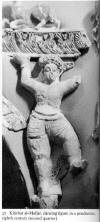 Figure 1 is a dancing figure, which
has arms overhead, an uplifted foot with the knee turned out on the same side,
and much of the weight on the right foot; the right hip appears to be slightly
shifted sideways. The dancer could be performing a move involving isolated foot
movements, about to place the foot downward into a stomp, about to cross the
foot over in front to start a grapevine, or posing in a manner similar to North
Indian dance.
Figure 1 is a dancing figure, which
has arms overhead, an uplifted foot with the knee turned out on the same side,
and much of the weight on the right foot; the right hip appears to be slightly
shifted sideways. The dancer could be performing a move involving isolated foot
movements, about to place the foot downward into a stomp, about to cross the
foot over in front to start a grapevine, or posing in a manner similar to North
Indian dance.
 Figure 2 is of two Persian dancers.
Their movements were most likely well planned (perhaps choreographed) as the
liquid from the jugs/vases is landing in the bowls, their arms are crossing each
other and their bodies are in similar positions. This painting demonstrates the
use of props as well as pair dancing. The dancers’ foot positions indicate a
hop, which is common in ME dance today as well. Note the long scarves draped
across the arms and shoulders, the short tunics and skirts and the belts (which
could be pearls, beads, etc.) fastened around the hips. Also note the caps which
conform to the shape of the head, the earrings (which are probably pearls) and
the braids that the dancers are wearing.
Figure 2 is of two Persian dancers.
Their movements were most likely well planned (perhaps choreographed) as the
liquid from the jugs/vases is landing in the bowls, their arms are crossing each
other and their bodies are in similar positions. This painting demonstrates the
use of props as well as pair dancing. The dancers’ foot positions indicate a
hop, which is common in ME dance today as well. Note the long scarves draped
across the arms and shoulders, the short tunics and skirts and the belts (which
could be pearls, beads, etc.) fastened around the hips. Also note the caps which
conform to the shape of the head, the earrings (which are probably pearls) and
the braids that the dancers are wearing.
 Figure 3 is a scarf dancer in a
Palermo ceiling painting. The majority of her weight is on the right leg (as her
back foot is on the ball of her foot), which is bent. Her left leg is fairly
straight. This indicates she is either doing a fairly large hop/leap, or doing a
step often performed today called the karshlima step; this step involves
stepping forward, having most of the weight on the forward leg, transferring the
weight to the back leg, and then stepping back with the same leg that was used
to step forward with. She is also looking back, which is a move commonly done
with the karshlima step. Her arms are framing her body and she appears to be
holding two small scarves in her hands. She is also using a fairly long narrow
scarf, of which one end is wrapped around her left arm, probably to keep it in
place. She is wearing a turban-like wrap on her head and a long garment that is
probably split in the front. It seems there is a second layer under the top
layer. She is also wearing pants and is barefoot. In front of her lies a jug or
vase, which she may have been dancing with and behind her someone plays a frame
drum with Arabic script on it.
Figure 3 is a scarf dancer in a
Palermo ceiling painting. The majority of her weight is on the right leg (as her
back foot is on the ball of her foot), which is bent. Her left leg is fairly
straight. This indicates she is either doing a fairly large hop/leap, or doing a
step often performed today called the karshlima step; this step involves
stepping forward, having most of the weight on the forward leg, transferring the
weight to the back leg, and then stepping back with the same leg that was used
to step forward with. She is also looking back, which is a move commonly done
with the karshlima step. Her arms are framing her body and she appears to be
holding two small scarves in her hands. She is also using a fairly long narrow
scarf, of which one end is wrapped around her left arm, probably to keep it in
place. She is wearing a turban-like wrap on her head and a long garment that is
probably split in the front. It seems there is a second layer under the top
layer. She is also wearing pants and is barefoot. In front of her lies a jug or
vase, which she may have been dancing with and behind her someone plays a frame
drum with Arabic script on it.
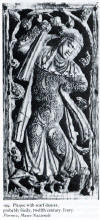 Figure 4 is in a position similar to
that of the scarf dancer in figure 3, only her back leg is probably more bent.
The placement of the many folds of fabric surrounding the dancer could be any of
the following: She may be holding a fairly large scarf and part of it is hanging
over her arm, and part of it trails behind her. She could also be holding a long
narrow scarf, and the back of her headdress is very long. Most likely, the folds
of fabric at the bottom are parts of her clothing (perhaps a full skirt or under
dress) that are coming out of a split in her well fitted over garment. Note her
head veil is pulled under her chin and tucked into a headband in a manner
similar to an Egyptian style.
Figure 4 is in a position similar to
that of the scarf dancer in figure 3, only her back leg is probably more bent.
The placement of the many folds of fabric surrounding the dancer could be any of
the following: She may be holding a fairly large scarf and part of it is hanging
over her arm, and part of it trails behind her. She could also be holding a long
narrow scarf, and the back of her headdress is very long. Most likely, the folds
of fabric at the bottom are parts of her clothing (perhaps a full skirt or under
dress) that are coming out of a split in her well fitted over garment. Note her
head veil is pulled under her chin and tucked into a headband in a manner
similar to an Egyptian style.
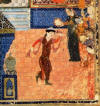 Figure 5 is featured in the painting
Humay on the Day After his Wedding Has Gold Coins Poured over Him as he
leaves Humayun’s Room from Khwaju Kirmani, Divan, Baghdad, 1396. Again, the
dancer appears to be in a similar position as figures 3 and 4. This dancer’s
back leg is clearly bent and the arms are in a position which makes it seem as
if they may be swinging to match a back and forth step such as the karshlima.
The dancer’s long narrow scarf is draped over both shoulders and is grasped in
both hands. The neckline of the fitted coat is similar to that of the Mongol
culture. Perhaps this dancer has traveled from a far land and learned a trade
supported in these lands. This also could just be a demonstration of the
blending of different influences within a culture. There is a white layer under
the top two layers and the coat is split at the sides. The split is most likely
a functional addition that dancers use to allow more movement. . The hat seems
trimmed with fur, and the hair seems to be in a bun at the base of the neck.
Musicians are playing the riq, the spoons or “clappers”, and some sort of wind
instrument. An interesting note on this painting is that the dancer appears to
be male and the musicians appear to be female.
Figure 5 is featured in the painting
Humay on the Day After his Wedding Has Gold Coins Poured over Him as he
leaves Humayun’s Room from Khwaju Kirmani, Divan, Baghdad, 1396. Again, the
dancer appears to be in a similar position as figures 3 and 4. This dancer’s
back leg is clearly bent and the arms are in a position which makes it seem as
if they may be swinging to match a back and forth step such as the karshlima.
The dancer’s long narrow scarf is draped over both shoulders and is grasped in
both hands. The neckline of the fitted coat is similar to that of the Mongol
culture. Perhaps this dancer has traveled from a far land and learned a trade
supported in these lands. This also could just be a demonstration of the
blending of different influences within a culture. There is a white layer under
the top two layers and the coat is split at the sides. The split is most likely
a functional addition that dancers use to allow more movement. . The hat seems
trimmed with fur, and the hair seems to be in a bun at the base of the neck.
Musicians are playing the riq, the spoons or “clappers”, and some sort of wind
instrument. An interesting note on this painting is that the dancer appears to
be male and the musicians appear to be female.
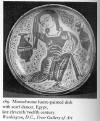 Figure 6 is an Egyptian scarf
dancer. She has her left knee up with the foot flat and her other knee is
touching the floor with the foot and lower leg back (not visible under her
clothing). She is either doing a “knee-walk” (moving from her current position
to one where the weight and knee positions are opposite) or coming up to a
standing position from doing floor work (movements done on the knees, in a
sitting position, etc.). Her arms frame her body while she holds two narrow
scarves. She is wearing a very fitted garment with a square neckline and long
sleeves adorned with tiraz bands. The garment is split in the front and on the
sides, as is evident by the way the garment is laying on the ground. She is
wearing a narrow scarf or belt, which seems to tie in the front. Note she is not
wearing a headdress, and her hair seems to curl up on the sides. Her eyebrows
meet in the middle, which was a standard of beauty in the Medieval Islamic
world.
Figure 6 is an Egyptian scarf
dancer. She has her left knee up with the foot flat and her other knee is
touching the floor with the foot and lower leg back (not visible under her
clothing). She is either doing a “knee-walk” (moving from her current position
to one where the weight and knee positions are opposite) or coming up to a
standing position from doing floor work (movements done on the knees, in a
sitting position, etc.). Her arms frame her body while she holds two narrow
scarves. She is wearing a very fitted garment with a square neckline and long
sleeves adorned with tiraz bands. The garment is split in the front and on the
sides, as is evident by the way the garment is laying on the ground. She is
wearing a narrow scarf or belt, which seems to tie in the front. Note she is not
wearing a headdress, and her hair seems to curl up on the sides. Her eyebrows
meet in the middle, which was a standard of beauty in the Medieval Islamic
world.
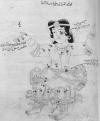 Figure 7 is a drawing of a dancer,
probably from Fars, 1009-10. This is probably of the manuscript of al-Sufi’s
Kitab Suwar al-Kawakib al Thabita, as Figure 8 is and they are very similar.
“Kitab Suwar al-Kawakib al Thabita was written by al-Sufi at the end of the
tenth century and was copied at the beginning of the eleventh century. It
contains images of the various constellations and is the oldest illustrated book
in Arabic to have survived.” (Irwin 1997) The dancers in both figures are most
likely spinning as the garments are “flying out” and have stylized ripples. Both
have their arms up and out as the dancer in figure 1 does. It seems in both
figures have 3 la
Figure 7 is a drawing of a dancer,
probably from Fars, 1009-10. This is probably of the manuscript of al-Sufi’s
Kitab Suwar al-Kawakib al Thabita, as Figure 8 is and they are very similar.
“Kitab Suwar al-Kawakib al Thabita was written by al-Sufi at the end of the
tenth century and was copied at the beginning of the eleventh century. It
contains images of the various constellations and is the oldest illustrated book
in Arabic to have survived.” (Irwin 1997) The dancers in both figures are most
likely spinning as the garments are “flying out” and have stylized ripples. Both
have their arms up and out as the dancer in figure 1 does. It seems in both
figures have 3 la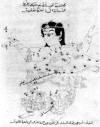 yers on the top and a pair of pants. The undermost layer on
figure 7 seems fairly transparent. The pants in these two figures seem slightly
different. While figure 7 seems to have a slit up the back of the pant legs,
figure 8 seems to have slight gathers around the ankle. Both are wearing jewelry
and a headband. Figure 8 has a more elaborate headpiece and the hair appears to
hang down while figure 7’s hair seems bound by a band of some sort.
yers on the top and a pair of pants. The undermost layer on
figure 7 seems fairly transparent. The pants in these two figures seem slightly
different. While figure 7 seems to have a slit up the back of the pant legs,
figure 8 seems to have slight gathers around the ankle. Both are wearing jewelry
and a headband. Figure 8 has a more elaborate headpiece and the hair appears to
hang down while figure 7’s hair seems bound by a band of some sort.
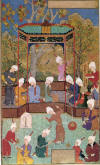 Figure 9 is called Night
Entertainment on a Terrace. This appears to be a group of men, the dancer
included, as I have only seen this type of hat and turban on men. The dancer has
most of his weight on the left foot, and the right foot slightly on the ball of
the foot. His arms are up in a fashion similar to figures 1, 7, and 8, but the
right hand is out and the left is pointing up. His torso is bent slightly to the
right and back, and his head, arms and hands gesture in that direction. This
seems to be a move that emphasizes the karshlima step. He is wearing a long
sleeved fitted coat, with at least one under layer. He also wears boots and a
belt, which may have plaques on it. Woodwind and string instruments as well as
the riq are being played.
Figure 9 is called Night
Entertainment on a Terrace. This appears to be a group of men, the dancer
included, as I have only seen this type of hat and turban on men. The dancer has
most of his weight on the left foot, and the right foot slightly on the ball of
the foot. His arms are up in a fashion similar to figures 1, 7, and 8, but the
right hand is out and the left is pointing up. His torso is bent slightly to the
right and back, and his head, arms and hands gesture in that direction. This
seems to be a move that emphasizes the karshlima step. He is wearing a long
sleeved fitted coat, with at least one under layer. He also wears boots and a
belt, which may have plaques on it. Woodwind and string instruments as well as
the riq are being played.
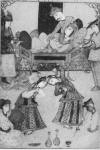 Figure 10 features two dancers in an
exaggerated torso position, similar to that in figure 9. Their arms are framing
their bodies, one up and one down. The one on the left appears to look at the
others face, while the one on the right seems to look at her partner’s feet. As
their feet are together, they may be going into deep backbends*** or into a
barrel turn. (Barrel turn: the torso stays as parallel to the floor as possible
while the feet turn quickly in a circle. The torso twists and the dancer “spots”
or looks at the floor to compensate.) The dancers are playing hand percussion
instruments while accompanying musicians play a woodwind instrument and the riq
while the usual happenings of the harem occur. The dancers are wearing several
layers. The layers from the waist down may be skirts or the bottoms of two of
the coats. Their hair is in plaits and they are wearing headbands over a
triangular headscarf (right) and a non-triangular headscarf. They are also
wearing narrow hip scarves tied in front at the top of the iliac crests.
Figure 10 features two dancers in an
exaggerated torso position, similar to that in figure 9. Their arms are framing
their bodies, one up and one down. The one on the left appears to look at the
others face, while the one on the right seems to look at her partner’s feet. As
their feet are together, they may be going into deep backbends*** or into a
barrel turn. (Barrel turn: the torso stays as parallel to the floor as possible
while the feet turn quickly in a circle. The torso twists and the dancer “spots”
or looks at the floor to compensate.) The dancers are playing hand percussion
instruments while accompanying musicians play a woodwind instrument and the riq
while the usual happenings of the harem occur. The dancers are wearing several
layers. The layers from the waist down may be skirts or the bottoms of two of
the coats. Their hair is in plaits and they are wearing headbands over a
triangular headscarf (right) and a non-triangular headscarf. They are also
wearing narrow hip scarves tied in front at the top of the iliac crests.
![]() Figure 11 is from Isfahan, Chihil
Sutun, and called Receiving Humayun, and while it is slightly past the time period
in question (late 1660’s), the clothing styles are as they were in period and
the dancers are in similar positions as those in figures 10 and 11 (which are in
period). Their feet are similar to that of the dancer’s in figure 10 (weight
more on the front foot and the one to the back is on the ball of the foot;
though, the dancer on the right has her foot completely off the ground.) It is
likely that these dancers are moving the torso to emphasize a hop or foot
movement similar to the karshlima. They have a large audience who largely seems
quite transfixed. Their long fitted coats are over two other layers, and they
are wearing boots or some other type of shoe. Their long rectangular hip scarves
are simply tied and not knotted; they have fringe on the ends. These are hung on
the iliac crest of one side and may have slipped down as a result of the scarves
having no knots.
Figure 11 is from Isfahan, Chihil
Sutun, and called Receiving Humayun, and while it is slightly past the time period
in question (late 1660’s), the clothing styles are as they were in period and
the dancers are in similar positions as those in figures 10 and 11 (which are in
period). Their feet are similar to that of the dancer’s in figure 10 (weight
more on the front foot and the one to the back is on the ball of the foot;
though, the dancer on the right has her foot completely off the ground.) It is
likely that these dancers are moving the torso to emphasize a hop or foot
movement similar to the karshlima. They have a large audience who largely seems
quite transfixed. Their long fitted coats are over two other layers, and they
are wearing boots or some other type of shoe. Their long rectangular hip scarves
are simply tied and not knotted; they have fringe on the ends. These are hung on
the iliac crest of one side and may have slipped down as a result of the scarves
having no knots.

Figure 12 is of dervishes dancing. The painting is from “a copy of Husayn Bayqara’s Majalis al-Ushshaq (Sessions of the Lovers), 16th century. Although disapproved of by some, listening to music, whirling, and dancing were practiced by many Sufi orders. The dancing might represent the movement of the soul toward God.” (Irwin 1997) They appear to be all men. Sufism is a part of Islam, and the Whirling Dervishes can trace their origin to the 13th Century Ottoman Empire. (http://www.dankphotos.com/whirling/) Note the arm positions and their similarity to many other figures featured. Also note that most are looking upwards, perhaps for divine inspiration. I should also note at this point that according to Shay, some would be shocked and offended to have dervish, or sufi, activity defined as dance.
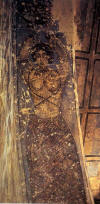 Figure 13 features a dancing girl on
the wall of a bathhouse in Jordan. She is noted as being in “caryatid” (sculptured
female figure serving as an ornamental support, in place of a column or
pilaster) pose. Her arms are overhead and seem to be holding a
basket or dish. Her right hip seems slightly shifted to the right, and her left
knee appears slightly turned out. She could be doing any number of moves from
this position, including a flat hip circle, a hip slide, a hip swing, etc.
Though some have argued that she has on a very sheer blouse with a short-sleeved
vest, it was not uncommon for dancers to be nude or partially nude in the
bathhouse. She appears to be nude from the waist up and wearing jewelry.
Figure 13 features a dancing girl on
the wall of a bathhouse in Jordan. She is noted as being in “caryatid” (sculptured
female figure serving as an ornamental support, in place of a column or
pilaster) pose. Her arms are overhead and seem to be holding a
basket or dish. Her right hip seems slightly shifted to the right, and her left
knee appears slightly turned out. She could be doing any number of moves from
this position, including a flat hip circle, a hip slide, a hip swing, etc.
Though some have argued that she has on a very sheer blouse with a short-sleeved
vest, it was not uncommon for dancers to be nude or partially nude in the
bathhouse. She appears to be nude from the waist up and wearing jewelry.
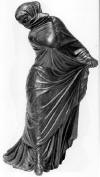 Figure 14 is a 2nd
century Hellenistic bronze statue from Alexandria. This fully veiled dancer has
an upraised hip with a flat foot. This is exactly how a “hip snap” or “hip bump”
is performed today. She also looks over her hip, as is common in some Egyptian
and Turkish styles today. Note the garment under her veil is quite full and it
seems her hair may be in a bun. Because of the position of the body, I
firmly believe this is a dancer, but some have wondered whether this is actually
just a model, and the sculptor was simply exhibiting his/her skill by showing
the lines of the body under layers of cloth. Perhaps the model was a
dancer and this stance was a natural one to display.
Figure 14 is a 2nd
century Hellenistic bronze statue from Alexandria. This fully veiled dancer has
an upraised hip with a flat foot. This is exactly how a “hip snap” or “hip bump”
is performed today. She also looks over her hip, as is common in some Egyptian
and Turkish styles today. Note the garment under her veil is quite full and it
seems her hair may be in a bun. Because of the position of the body, I
firmly believe this is a dancer, but some have wondered whether this is actually
just a model, and the sculptor was simply exhibiting his/her skill by showing
the lines of the body under layers of cloth. Perhaps the model was a
dancer and this stance was a natural one to display.
 Figure 15 is a 16th
century dancing yakshi. Her right hip is clearly isolated from her torso
while the right leg is fairly straight and the left one is fairly bent. This
move is similar to moves performed in Classical Indian dance or Kathak dance,
which is a mix of Islamic and Hindu influences (http://www.xensei.com/users/docued/films/circles-cycles.html).
The isolation of body parts is a common (and necessary for the proper effect)
part in Middle Eastern dance. As the Rom traveled out of India into various
parts of the Middle East, they no doubt brought their dance and influences with
them.
Figure 15 is a 16th
century dancing yakshi. Her right hip is clearly isolated from her torso
while the right leg is fairly straight and the left one is fairly bent. This
move is similar to moves performed in Classical Indian dance or Kathak dance,
which is a mix of Islamic and Hindu influences (http://www.xensei.com/users/docued/films/circles-cycles.html).
The isolation of body parts is a common (and necessary for the proper effect)
part in Middle Eastern dance. As the Rom traveled out of India into various
parts of the Middle East, they no doubt brought their dance and influences with
them.
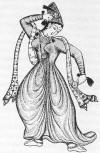 Figure 16 is of an Indian dancer.
She wears the clothing of a lady of high rank during the Mogul period. She is
playing hand percussion instruments as in figure 10 and drapes a long narrow
scarf about her similar to those in figures 2, 3, and 5. Her arm position is
somewhat similar to figures 3, 4, 5, 6, and especially 10.The bells around her
ankles are most likely emphasizing foot movements, as indicated by the
out-turned feet. Many Indian dances today feature foot movements, which are
accented by ankle bells.
Figure 16 is of an Indian dancer.
She wears the clothing of a lady of high rank during the Mogul period. She is
playing hand percussion instruments as in figure 10 and drapes a long narrow
scarf about her similar to those in figures 2, 3, and 5. Her arm position is
somewhat similar to figures 3, 4, 5, 6, and especially 10.The bells around her
ankles are most likely emphasizing foot movements, as indicated by the
out-turned feet. Many Indian dances today feature foot movements, which are
accented by ankle bells.
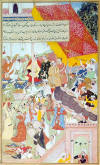 Figure 17 is a painting from the
early 16th century called Indian Kathak entertainers at the
Marriage of Bagi Muhammad Khan. The dancers are dressed in a fashion very
similar to figure 16. The dancer on the right is in a similar stance as figure
16 and is playing “clappers”. The dancer to the left has her arms overhead as
many other featured figures do. Her arms are raised so high that they are almost
similar to flamenco dancing. Flamenco as we know it today was developed after
the 17th century. As Kathak dancing is a mix of Hindu and Islamic influences
the clothing also seems to be a mix of Hindu and Islamic influences in this
painting. It makes sense that the intermingling of cultures in the 16th
century has influenced what we know as Middle Eastern dance now. Note the many
different instruments being played, especially the large drums. Also of note is
that a Middle Eastern dancer is a vital part of a Middle Eastern wedding
celebration, and there are two figures here that have featured dancers at a
wedding celebration.
Figure 17 is a painting from the
early 16th century called Indian Kathak entertainers at the
Marriage of Bagi Muhammad Khan. The dancers are dressed in a fashion very
similar to figure 16. The dancer on the right is in a similar stance as figure
16 and is playing “clappers”. The dancer to the left has her arms overhead as
many other featured figures do. Her arms are raised so high that they are almost
similar to flamenco dancing. Flamenco as we know it today was developed after
the 17th century. As Kathak dancing is a mix of Hindu and Islamic influences
the clothing also seems to be a mix of Hindu and Islamic influences in this
painting. It makes sense that the intermingling of cultures in the 16th
century has influenced what we know as Middle Eastern dance now. Note the many
different instruments being played, especially the large drums. Also of note is
that a Middle Eastern dancer is a vital part of a Middle Eastern wedding
celebration, and there are two figures here that have featured dancers at a
wedding celebration.
In conclusion, while these figures are limited in number, we have been able to draw many conclusions about what the dance could have looked like. It seems to be very similar to what much of Middle Eastern dance is today. The clothing patterns have not changed much until recently throughout these regions for various reasons, so it makes sense that the dance has not changed much either. Especially in Persian and Uzbeck dance, those who perform and study the dances of these regions maintain that the dance forms have remained pure. All the written descriptions we have combined with poses lend strength to this argument. In addition, we have the additional advantage of practicing “living archeology”. That is, we learn through doing. We wear the clothing of these time periods, and attempt the movements we see in art to come up with a dance style that is likely what was performed in the past. By wearing the clothing of the time period, our dance is shaped differently. We learn which moves feel best and are best emphasized in each particular style of clothing. A modern cabaret dancer wearing a bra and skirt dances very differently than a dancer in a Turkish yelik.
Though the views are clouded, many out of period European travelers wrote of what they saw of the dancers throughout these regions. Their descriptions are similar to those in period and much of what the dance looks like now. We may assume that since the dance was passed down orally, and there are written descriptions of what the dance looked like before and after the given time period that its existence survived in the Middle Ages and Renaissance in a form similar to what we know of the dance today.
Currently, a Turkish dance manual has been discovered, attempts are being made to translate it, and we will have much greater insight into this dance. There are also a number of art pieces I have not seen which feature dancers in different movements. I have been told that the “zodiac dancers” feature quite a few hip movements. While my collection grows, so will this research.
Salaam!
Back to topBiblography
Buonaventura, Wendy. (1998) Serpent of the Nile, Women and Dance in the Arab World. Interlink Books, Brooklyn, New York
Blair, Sheila S. and Bloom Jonathan M. (1994) The Art and Architecture of Islam 1250-1800. Yale University Press, New Haven and London
Ettinghausen, Richard, and Grabar, Oleg (1987) The Art and Architecture of Islam 650-1250. Yale University Press, New Haven and London
Chamas, Jalilah Lorrane (Downloaded from the WWW 4-26-04) Oriental Dance: Myth and Reality, the Harem Slaves (http://www.gildedserpent.com/articles20/jalilahharamslaves.htm)
Circles-Cycles Kathak Dance downloaded from the WWW 8/8/00- (http://www.xensei.com/users/docued/films/circles-cycles.html)
Hambley, Gavin R.G. (1998) Women in the Medieval Islamic World Power, Patronage, and Piety. St. Martin’s Press, New York
Henderson-Harding, Karol, Creative Anachronist #70- The World’s Oldest Dance: Origins of Oriental Dance
Irwin, Robert. (1997) Islamic Art in Context. Harry N. Abrams, Inc. NY, NY
Robinson, B.W. (1965) Persian Drawings from the 14th through the 19th Century. Little, Brown and Company, Boston, Toronto
Shay, Anthony. (1999) Choreophobia, Solo Improvised Dance in the Iranian World. Mazda Publishers, Costa Mesa, California
Van Nieuwkerk, Karin. (1995) A Trade Like Any Other, Female Singers and Dancers in Egypt. University of Texas Press, Austin, TX
Walther, Wiebke. (1993) Women in Islam From Medieval to Modern Times. Markus Wiener Publishing, Princeton and New York
Whirling Dervishes- A Search for Spirituality downloaded from the WWW 8/8/00 -
(http://www.dankphotos.com/whirling/)